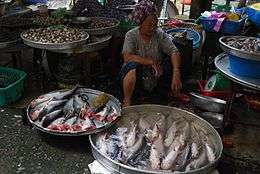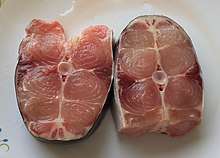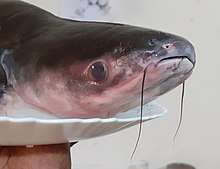Basa (fish)
Basa (Pangasius bocourti) is a species of catfish in the family Pangasiidae. Basa are native to the Mekong and Chao Phraya basins in Mainland Southeast Asia.[2] These fish are important food fish with an international market. They are often labelled in North America and Australia as "basa fish", "swai",[3] or "bocourti".[4] In the UK all species of Pangasius may legally be described as "river cobbler", "cobbler", "basa", "pangasius", "panga", or any of these with the addition of "catfish".[5] In the rest of Europe, these fish are commonly marketed as "pangasius" or "panga".[6] Other related shark catfish may occasionally be incorrectly labeled as basa fish, including P. hypophthalmus (iridescent shark) and P. pangasius (yellowtail catfish).
| Basa | |
|---|---|
 | |
| Basa fish in Vinh Long market, Vietnam | |
| Scientific classification | |
| Kingdom: | Animalia |
| Phylum: | Chordata |
| Class: | Actinopterygii |
| Order: | Siluriformes |
| Family: | Pangasiidae |
| Genus: | Pangasius |
| Species: | P. bocourti |
| Binomial name | |
| Pangasius bocourti Sauvage, 1880 | |
Description
The body of the basa is stout and heavy. The rounded head is broader than it is long, with the blunt snout having a white band on its muzzle. This species grows to a maximum length of 120 centimetres (47 in).[2]
Ecology and lifecycle
Basa fish feed on plants. They spawn at the onset of flood season and the young are first seen in June, averaging about 5 centimetres (2.0 in) by mid-June.[2]
Market



"Catfish war" in the U.S.
In 2002, the United States accused Vietnam of dumping catfish, namely P. bocourti and P. hypophthalmus, on the American market, arguing that the Vietnamese exporters, who are subsidised by Vietnam's government, constituted unfair competition.[7][8] With pressures from the U.S. catfish industry, the United States Congress passed a law in 2003 preventing the imported fish from being labelled as catfish, as well as imposing additional tariffs on the imported fish.[9] Under the U.S. Food and Drug Administration ruling, only species from the family Ictaluridae can be sold as true catfish.[3] As a result, the Vietnamese exporters of this fish now label their products sold in the U.S. as basa fish, striped pangasius, swai or bocourti.[10][11]
At the height of the "catfish war", U.S. catfish farmers and others were describing the imported catfish as an inferior product. However, Mississippi State University researchers found imported basa were preferred three-to-one to US catfish in a small (58 testers) blind taste test.[12]
United Kingdom
Basa has become common in the UK as "Vietnamese river cobbler", "river cobbler", or "basa". It is mainly sold by large supermarkets, in both fresh and frozen forms, as a more reasonably priced alternative to popular white fish such as cod or haddock. Young's uses it in some of its frozen fish products, under the name basa.[13] The import of basa is subject to the same stringent EU regulations as other food imports, as set out in the CBI pangasius product fact sheet [14] UK Trading Standards officers said that cobbler was being fraudulently sold as cod by some fish-and-chip retailers to take advantage of the much lower price of cobbler, which was about half that of cod. This practice was highlighted by the successful prosecution of two retailers, using DNA evidence, in 2009 and 2010.[15][16] Sometimes pangasius is described, legally, simply as "fish", as in "fish and chips".[16]
Environmental and health concerns
Several environmental organisations concerned with marine ecosystems have raised concerns about basa. OceanWise, an environmental organisation associated with the Vancouver Aquarium, has flagged farmed basa for its potential pollution of ecosystems and interference with wild species.[17] It writes, "Open cage farming in Southeast Asia is associated with disease transfer to wild basa. There are also concerns about feed quality, farm operating standards and the biological impact of using wild stock for culturing."[17] The Monterey Bay Aquarium currently lists the basa in its "red flag" or "avoid" category.[18] Both groups cite USA farmed catfish as a more sustainable alternative.
Tests by Asda and Tesco in the UK have found no trace of toxic contaminants.[19] Test from AQIS found trace levels of malachite green, but no other contaminants.[20][21][22]
One case has been reported of a person without a general fish allergy having an anaphylactic reaction to pangasius.[23][24]
References
- Vidthayanon, C. (2012). "Pangasius bocourti". The IUCN Red List of Threatened Species. IUCN. 2012: e.T180848A1669669. doi:10.2305/IUCN.UK.2012-1.RLTS.T180848A1669669.en.
- Froese, Rainer and Pauly, Daniel, eds. (2012). "Pangasius bocourti" in FishBase. February 2012 version.
- "Basa/Swai" (PDF). SeaFood Business magazine. Archived from the original (PDF) on 6 January 2009. Retrieved 31 January 2009.
- "CFIA Fish List". Canadian Food Inspection Agency. 7 July 2010. Archived from the original on 26 March 2012. Retrieved 30 June 2011.
- "Fish Labelling (Amendment) (England) Regulations 2006" (PDF). COT. 26 May 2007. Retrieved 22 July 2009.
- "Vietnam catfish farmers angered by French reports". Monsters and Critics. 19 May 2008. Archived from the original on 10 December 2008. Retrieved 31 January 2009.
- Becker, Elizabeth (16 January 2002). "Delta Farmers Want Copyright on Catfish". The New York Times. Archived from the original on 30 January 2009. Retrieved 31 January 2009.
- Armstrong, David (8 February 2003). "Food Fight: U.S. accuses Vietnam of dumping catfish on the American market". San Francisco Chronicle. Retrieved 31 January 2009.
- Philadelphia, Desa (25 February 2002). "Catfish by Any Other Name". Time. New York. Archived from the original on 26 January 2009. Retrieved 31 January 2009.
- "Buyer's Guide: Basa Catfish". SeaFood Business magazine. November 2001. Archived from the original on 22 March 2007. Retrieved 31 March 2007.
- Greenberg, Paul (9 October 2008). "A Catfish by Any Other Name". The New York Times. Retrieved 31 January 2009.
- McConnaughey, Janet (19 July 2005). "Vietnam has tastier fish than US: studies". Independent Online (South Africa). SAPA-AP. Retrieved 31 January 2009.
- "Basa fillets". youngsseafood.co.uk. Archived from the original on 23 April 2013. Retrieved 16 July 2013.
- "Exporting Pangasius to Europe". CBI Ministry of Foreign Affairs. Retrieved 5 July 2019.
- Elliott, Valerie (13 July 2009). "Fish and chip shops accused of selling Vietnamese cobbler as cod". The Times. London. Retrieved 22 July 2009. (subscription required)
- "Chip shop owner admits fish fraud". BBC News. 15 April 2010. Archived from the original on 12 March 2012. Retrieved 26 April 2010.
- "CatfishBasa - Ocean Wise". oceanwise.ca. Archived from the original on 22 January 2013. Retrieved 21 February 2013.
- "Monterey Bay Aquarium SeafoodWatch Guide" (PDF). Monterey Bay Aquarium SeafoodWatch. Retrieved 15 January 2017.
- BBC Watchdog report Archived 17 July 2011 at the Wayback Machine
- Food Standards Australia Archived 23 April 2011 at the Wayback Machine Report 2005
- "Biosecurity in Australia Review of Provisions in the Australian New Z…". agriculture.gov.au. 30 October 2014. Archived from the original on 30 October 2014.
- Positive only statements Archived 28 March 2012 at the Wayback Machine from Seafood Importers Association, a lobby organisation for fish importing companies
- Ebo, DG; Kuehn, A; Bridts, CH; Hilger, C; Hentges, F; Stevens, WJ (2010). "Monosensitivity to pangasius and tilapia caused by allergens other than parvalbumin" (PDF). J Investig Allergol Clin Immunol. 20 (1): 84–8. PMID 20232779.
- "Leicester Mercury: Fish and chips nearly a deadly dish for allergy patient Luke, 24 January 2011". leicestermercury.co.uk. Archived from the original on 15 December 2013. Retrieved 15 December 2013.
Further reading
- Kulabtong, Sitthi. "Biology and Culture Techniques of Bocourti Catfish, Pangasius bocourti Sauvage, 1880 in Thailand". Veridian E-Journal, Silpakorn University, 5(3): 411–419, 2012.
- Heavy Reham, A. Amin. Heavy metal residues in imported frozen fish and Pangasius hypophthalmus (Basa) fish fillets
- Fish Molee, a popular Kerala fish curry made with Basa
| Wikimedia Commons has media related to Pangasius bocourti. |
| Wikispecies has information related to Pangasius bocourti |


